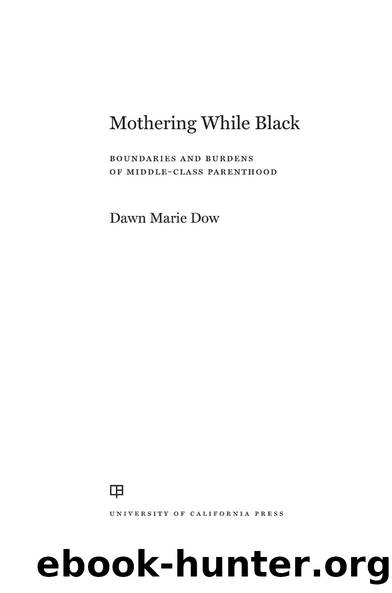Mothering While Black by Dawn Marie Dow

Author:Dawn Marie Dow [Dow, Dawn Marie]
Language: eng
Format: epub
Tags: Social Science, Social Classes & Economic Disparity, Ethnic Studies, African American Studies, Gender Studies, Family & Relationships, Parenting, Motherhood
ISBN: 9780520300316
Google: tAmBDwAAQBAJ
Publisher: Univ of California Press
Published: 2019-03-05T04:14:48+00:00
DOMINANT PERSPECTIVES ON WOMANHOOD AND MOTHERHOOD IN WORKâFAMILY RESEARCH
The cult of domesticity and separate spheres are two related ideologies that have been integral in organizing Americaâs gendered division of labor and the relationship between the marketplace and the family.10 Together, these ideologies relegate women to the domestic sphere, foster a societal belief that a womanâs place is in the home, and specify how womenâs work should be enacted and evaluated.11 These ideologies largely free men from regular domestic duties and support a stark division between the private world of the family and the public world of work and demand a strict gendered division of labor within both.12
These ideologies of womanhood and motherhood did not always exist. They emerged in the late eighteenth century and early nineteenth century during the Industrial Revolution, when capitalism became a durable part of modern American society.13 These ideologies were initially forged in the homes of the white middle- and upper-middle-class and, ultimately, were presented to all white women and men as an ideal to which to aspire and the standard against which to evaluate their family and work decisions.14 These ideologies supported the new economic order of modern industrial capitalism by encouraging a new gendered division of labor in the household and marketplace and a new vision of motherhood. Before the Industrial Revolution, the public and private spheres were not as divided.15 Indeed, the work of the family within the homeâwhat Dorothy Smith has referred to as womenâs lived experienceâwas integrated with market work, and men, women, and children were all active participants.16 Many white working-class families continued to need womenâs economic contributions, but their lack of conformity to the ideal was less visible to the public eye because they were often able to engage in paid work inside their homes, such as taking in boarders or engaging in piecework.17
The logics of separate spheres and the cult of domesticity were used to create changes in labor laws and policies that reinforced menâs status as breadwinners and womenâs status as homemakers.18 Progressive Era maternalist reformers used both ideologies as key rationales to regulate womenâs activities in the public sphere and to create government initiatives that would enable mothers to focus their attention on caring for their children and their homes.19 The logic behind these ideologies also undergirded the creation of early welfare policies, including widowsâ and mothersâ pensions that provided certain groups of mothers with financial support to reduce or eliminate their workday, permitting them to stay at home and raise their children.20 Although these pensions were often symbolic, functioning more often as economic subsidies for low-income white mothers rather than entirely eliminating their need to work,21 they sent a powerful message that, under ideal circumstances, white mothers should stay at home and care for their children.
These ideologies also influenced changes to labor laws that permitted regulations limiting a womanâs workday based on the rationale that women should be able to focus on their duties within the domestic sphere.22 In Muller v. Oregon, in a unanimous
Download
This site does not store any files on its server. We only index and link to content provided by other sites. Please contact the content providers to delete copyright contents if any and email us, we'll remove relevant links or contents immediately.
Nudge - Improving Decisions about Health, Wealth, and Happiness by Thaler Sunstein(7622)
iGen by Jean M. Twenge(5367)
The Fire Next Time by James Baldwin(5251)
Adulting by Kelly Williams Brown(4489)
The Hacking of the American Mind by Robert H. Lustig(4319)
The Sports Rules Book by Human Kinetics(4299)
The Ethical Slut by Janet W. Hardy(4178)
Captivate by Vanessa Van Edwards(3796)
Mummy Knew by Lisa James(3637)
In a Sunburned Country by Bill Bryson(3486)
The Worm at the Core by Sheldon Solomon(3437)
Ants Among Elephants by Sujatha Gidla(3417)
The 48 laws of power by Robert Greene & Joost Elffers(3031)
Suicide: A Study in Sociology by Emile Durkheim(2975)
The Slow Fix: Solve Problems, Work Smarter, and Live Better In a World Addicted to Speed by Carl Honore(2950)
Humans of New York by Brandon Stanton(2835)
The Tipping Point by Malcolm Gladwell(2829)
Handbook of Forensic Sociology and Psychology by Stephen J. Morewitz & Mark L. Goldstein(2660)
The Happy Hooker by Xaviera Hollander(2655)
